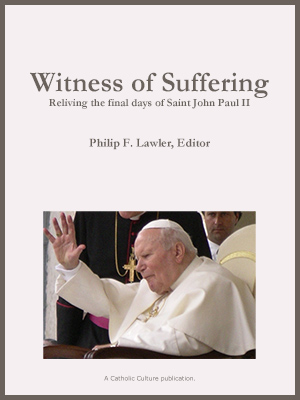Two cheers for Vatican security
By Phil Lawler ( bio - articles - email ) | Feb 03, 2015
Iana Azhdanova is persona non grata at the Vatican.
You may not remember the name, but Azhdanova is the Ukrainian leader of Femen, the feminist group that specializes in topless public demonstrations. On the day after Christmas she tore off her top and grabbed the figure of the baby Jesus from the crèche display in St. Peter’s Square, shouting, “God is woman.” She was quickly arrested, but soon released with the admonition that she should never again enter the territory of Vatican City.
Fair enough. The Vatican prosecutor might have pressed charges, but Azhdanova no doubt wanted to portray herself as a victim of Church persecution, and the Vatican denied her that extra helping of publicity.
Marcello di Finizio, on the other hand, is going to face criminal charges. He’s the man who has climbed out onto the roof of St. Peter’s basilica waving placards in a bid to call attention to his private battle against certain trade regulations of the European Union. What makes his case noteworthy—and has prompted the Vatican to treat it seriously—is di Finizio’s persistence. He has now pulled this stunt not once or twice, but five times.
It might have made sense, after the first (or second or third) such incident, for security officers to tell di Finizio, too, that he was no longer welcome on Vatican territory. Perhaps they did. But even if they didn’t, after coaxing wouldn’t they have become familiar with the man’s appearance? Couldn’t photos have been posted, so that security officers were on the alert? Tourists and pilgrims have access to the roof of the basilica, but there are several narrow checkpoints along the route, where security officers could pick out a familiar face and stop him from another dash onto the dome.
Maybe I’m being unrealistic. Maybe it’s too much to expect that, with thousands of people passing by, guards would recognize a single face. But let me turn now to another case, and an even more familiar face.
To keep things in perspective, spending the night on the dome of St. Peter’s is not the most serious crime that has been committed inside Vatican City in recent years. What is the most serious crime? That’s an easy question to answer: the attempted assassination of St. John Paul II.
Just after Christimas, Mehmet Ali Agca, the man who shot the Pope, returned to the Vatican, to place flowers on the tomb of the man he once tried to kill. Why was he allowed onto Vatican territory?
In this case it’s extremely unlikely that Agca slipped by security officers. His face has been shown in thousands of television broadcasts and newspaper headlines around the world. Moreover, when he arrived at the Vatican in December he was accompanied by a television cameraman who was recording his visit. Television cameras tend to draw attention.
At the time, Father Ciro Benedettini, the deputy director of the Vatican press office, said that Agca was free to visit because there were no criminal charges pending against him. (After being convicted of the assassination attempt, he was pardoned by the Italian government, with the encouragement of Pope John Paul II, in 2000.) Yes, I understand that there was no reason to arrest him when he arrived. Yes, I assume that Vatican security guards kept a careful eye on him while he was there. But was the Vatican obliged to admit him?
Mehmet Ali Agca may no longer pose a threat of violence. Still the one-time Turkish gunman has a history of wild, extravagant public statements, suggestive of a severe emotional imbalance and a thirst for publicity. (He arrived in Rome just a few weeks after announcing that he wanted to meet with Pope Francis during the Pontiff’s trip to Turkey.) Granted, there was very little likelihood that he would attempt another assassination. But there was a very distinct possibility that he would made a public scene—just as Iana Azhdanova made a scene. More important, his return to St. Peter’s Square told the world that a convicted killer can easily gain access to the Vatican, even if he is recognized.
As Christians we are obliged to forgive our neighbors for their offenses. But we are not required to give them further opportunities for mischief. The decision to bar Iana Azhdanova from Vatican territory seems to me eminently sensible—as long as it is enforced. The failure to block Marcello di Finizio from his repeated assaults on the dome of St. Peter’s makes me question the efficacy of the security checkpoints at the Vatican basilica. But the decision finally to press charges against him is a refreshing sign of seriousness. A Vatican crackdown on unruly demonstrators is welcome.
The willingness to accommodate a highly publicized visit by Mehmet Ali Agca, however, is a different matter entirely. Here the issue is not the efficiency of security arrangements, but the policies set by Vatican officials. At a time when there are frequent reports of terrorist threats against the Vatican, it is unsettling that the Vatican allowed a highly publicized visit by a would-be assassin.
All comments are moderated. To lighten our editing burden, only current donors are allowed to Sound Off. If you are a current donor, log in to see the comment form; otherwise please support our work, and Sound Off!









